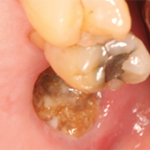It’s the latest study to show the superiority of denosumab in patients who’ve previously been treated with bisphosphonates. Previous studies have compared the drug to risedronate, alendronate and ibandronate.1-4
“This study completes a suite of trials,” he said, “that shows transitioning from a bisphosphonate to DMAb provides greater increases in BMD (bone mineral density) and reduction in bone turnover markers compared to maintaining therapy with another bisphosphonate.”
A20 Mutations

Dr. Zhou
In another study, Qing Zhou, PhD, a researcher with the National Human Genome Research Institute of the National Institutes of Health, described a new auto-inflammatory disease involving mutations in the TNFAIP3 gene, which causes haploinsufficiency of the A20 anti-inflammatory protein.5
“The patient presents with a childhood onset of systemic inflammation and some features resemble Behçet’s disease,” Dr. Zhou said. The features include skin lesions, oral and genital ulcers, ocular inflammation, arthralgia and arthritis and GI inflammation. Researchers have called the disease HA20.
The work began with two families in whom A20 mutations were found with exome sequencing, which led to the screening of 150 other patients with similar clinical features.
Those with the A20 mutations, researchers found, do not inhibit tumor necrosis factor-induced activation of the NF-kB inflammatory pathway. And there is an overproduction of inflammatory cytokines—such as IL-1-beta, tumor necrosis factor and IL-6—in these patients, they found.
These A20 mutations activate the NLRP3 inflammasome, which has been recognized as the body’s most influential and versatile signaling platform for inflammatory disorders.6
There have been positive, though early, results using an agent targeting IL-1-beta, Dr. Zhou said.
“These findings raise the possibility of new targeted therapies for this spectrum of disease,” she said.
Opportunity for Scleroderma Treatment
In other findings, Raymond Ong Jr., a researcher at Singapore General Hospital, described new insights into the interplay between the microenvironment of the skin and the periphery in scleroderma that might provide an opportunity for treatment.

Mr. Ong
In scleroderma (SSc), he said, there is an unmet need to identify and describe immune cell phenotypes that are involved in scleroderma pathogenesis to drive development of targeted therapies.
In this trial, he said, researchers hypothesized that immune signatures found at the interface of the microenvironment and systemic immunity both define disease pathogenesis and dictate outcomes in scleroderma patients.
Researchers employed an array of “high throughput” technologies to study 23 subjects—including scleroderma subjects and healthy controls—in search of immune signatures clustered meaningfully at the level of single cells. They used gene expression studies with human dermal fibroblasts stimulated with an autoantigen (Topo I) that’s linked with SSc; mass spectrometry analysis of peripheral blood; and RNA sequence analysis.


